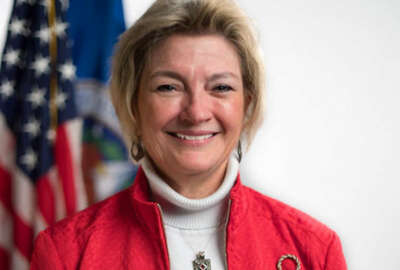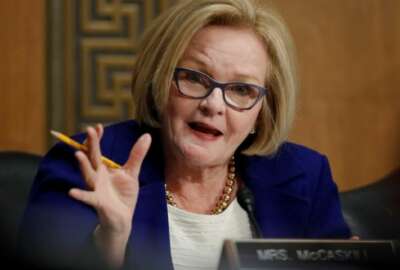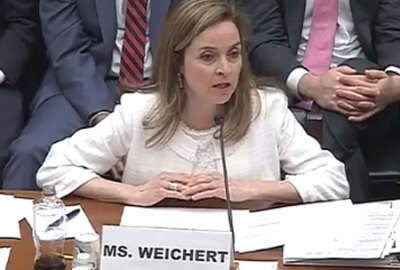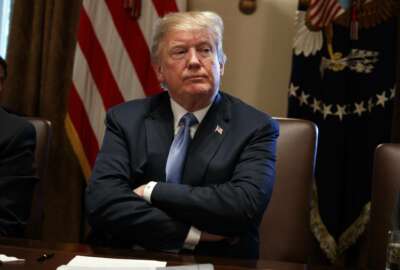
OPM, GSA map out phases for proposed reorganization
The Office of Personnel Management and General Services Administration said they're still considering if and when they might move retirement and health services...
Best listening experience is on Chrome, Firefox or Safari. Subscribe to Federal Drive’s daily audio interviews on Apple Podcasts or PodcastOne.
A complete overhaul of the Office of Personnel Management, as the Trump administration first suggested in its reorganization proposals, won’t happen overnight.
Both OPM and the General Services Administration say they’re breaking the proposed reorganization into pieces. No moves are set in stone — yet.
But both agencies said they’re “pretty far along” and are operating with “deliberate speed” on the move of HR Solutions, the fee-for-service entity within OPM that provides products and services to help agencies with their human resources needs.
HR Solutions manages USAJOBS.gov, USA Staffing and USA Hiring, among other projects.
OPM and GSA have created task forces to review both organizations, as Federal News Radio has previously reported. The groups are reviewing commonalities between both agencies and developing a timeline and action plan.
“We’re taking these things in phases,” OPM Director Jeff Pon told members of the Senate Homeland Security and Governmental Affairs Committee on Thursday. “We can’t do it all at once. We’re taking a look at what authorities we have administratively and what we need to work with Congress [on.]”
For HR Solutions, both agencies believe they can make the move themselves without help from Congress. The agencies’ legal teams are still reviewing whether they could move retirement and health services from OPM to GSA without congressional authority, Pon and Murphy said.
GSA Administrator Emily Murphy said she expects the task forces will have a timeline ready for HR Solutions in late summer or early fall.
But further decisions on moving OPM’s existing retirement and health services are less certain.
“The transition of either retirement or health care to GSA has not been decided,” Murphy told the committee. “That’s a phase two issue. It’s one that we’re continuing to do a lot of exploration.”
Both leaders said they may recommend a move of OPM retirement and health services to GSA in the 2020 or 2021 budget.
The decision to shift retirement and health is more complicated, in part, because OPM first wants to modernize the federal employee retirement system — instead of handing the keys for the agency’s retirement processing center in Boyers, Pennsylvania, to GSA.
“The employee digital record will help agencies move people from agency to agency and move them to retirement systems without the paper,” Pon said. “I want to make sure that we deliver that in good order to GSA, so the digital infrastructure can be worked on together. I’m not having [Murphy] and the GSA organization inherit some of the problems that OPM has been dealing with for decades. I want to make sure on my watch that we move to a digital environment, and that will take at least a year or two.”
OPM has tried several times in recent history to modernize its retirement system. Most attempts haven’t received dedicated funding and were pushed aside to deal with other priorities. Pon, however, wants to modernize the retirement systems as part of a broader effort to develop an employee digital record.
The record would pull in data from an employee’s official personnel file, other human resources, payroll, health and other systems, Pon said. It would track an employee’s entire federal career, from hiring to retirement.
Little discussion on OPM personnel policy
Few senators, except for Sen. Kamala Harris (D-Calif.), had questions about perhaps the most controversial piece of OPM’s reorganization proposals: moving the agency’s personnel policy functions to the Executive Office of the President.
Harris said she was concerned about the implications the potential move would have for an apolitical federal workforce if a political entity developed policy for career employees.
“None of the responsibilities or roles right now are proposed to change,” Pon said of the OPM policy offices. “It’s the service functions and transactional systems that is the focus of our current planning. All of the policies and rights of the OPM director, the role of the OPM director, still stays in this organization and entity.”
Pon said he “thinks” he would still report to the president as OPM director. When asked about the potential move of the agency’s personnel and HR policy functions to the White House, Pon told reporters after Thursday’s hearing that OPM’s legal teams were still reviewing whether such a move could be made. If it could, they would advocate for those offices to move to the White House, he said.
Once again, committee members said they were interested in where the proposals to shift OPM services to GSA originated. Sen. Maggie Hassan (D-N.H.) took the lead on that question, but she didn’t receive a detailed answer.
Pon described how the administration developed an executive order and guidance and solicited public comments under the reorganization initiative, but he didn’t specify who had first suggested the OPM reorganization.
The origin of the OPM and GSA reorganization proposals, however, didn’t receive much more attention, and senators didn’t nearly express the same outrage as they did during last week’s reorganization hearing with the Office of Management and Budget.
Sen. Heidi Heitkamp (D-N.D.), the regulatory affairs and federal management subcommittee ranking member, however, did need some convincing that GSA is the right entity to pick up some of OPM’s responsibilities.
“Somehow just rearranging the chairs or sits where, in my opinion, doesn’t solve some of the problems that I see that need to be solved with an OPM,” she said.
But Murphy said GSA is well-positioned to take over some of OPM’s existing functions and serve as government’s main administrative services entity.
“If you’re coming to either GSA or OPM right now and trying to use the human capital training services contract, it’s unclear where you’re supposed to go,” Murphy said. “By bringing these two groups together, it’s going to be much easier for our customers.”
Copyright © 2025 Federal News Network. All rights reserved. This website is not intended for users located within the European Economic Area.
Nicole Ogrysko is a reporter for Federal News Network focusing on the federal workforce and federal pay and benefits.
Follow @nogryskoWFED
Related Stories






